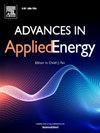Advancing building facade solar potential assessment through AIoT, GIS, and meteorology synergy
IF 13.8
Q1 ENERGY & FUELS
引用次数: 0
Abstract
The assessment of building solar potential plays a pivotal role in Building Integrated Photovoltaics (BIPV) and urban energy systems. While current evaluations predominantly focus on rooftop solar resources, a comprehensive analysis of building facade BIPV potential is often lacking. This study presents an innovative methodology that harnesses state-of-the-art Artificial Intelligence of Things (AIoT) techniques, Geographic Information Systems (GIS), and Meteorology to develop a model for accurately estimating spatial–temporal building facade BIPV potential considering 3 Dimension (3D) shading effect. Here, we introduce a zero-shot Deep Learning framework for detailed parsing of facade elements, utilizing cutting-edge techniques in Large-scale Segment Anything Model (SAM), Grounding DINO (Detection Transformer with improved denoising anchor boxes), and Stable Diffusion. Considering urban morphology, 3D shading impacts, and multi-source weather data enables a meticulous estimation of solar potential for each facade element. The experimental findings, gathered from a range of buildings across four countries and an entire street in Japan, highlight the effectiveness and applicability of our approach in conducting comprehensive analyses of facade solar potential. These results underscore the critical importance of integrating shadow effects and detailed facade elements to ensure accurate estimations of PV potential.
通过AIoT、GIS和气象学协同推进建筑立面太阳能潜力评估
建筑太阳能潜力评估在建筑综合光伏系统和城市能源系统中起着至关重要的作用。虽然目前的评估主要集中在屋顶太阳能资源,但对建筑立面BIPV潜力的综合分析往往缺乏。本研究提出了一种创新的方法,利用最先进的物联网人工智能(AIoT)技术、地理信息系统(GIS)和气象学来开发一个模型,用于准确估计考虑三维(3D)阴影效应的建筑立面BIPV时空潜力。在这里,我们介绍了一个零采样深度学习框架,用于详细解析立面元素,利用大规模分段任意模型(SAM)、接地DINO(改进去噪锚盒检测变压器)和稳定扩散中的尖端技术。考虑到城市形态、3D阴影影响和多源天气数据,可以对每个立面元素的太阳能潜力进行细致的估计。实验结果来自四个国家的一系列建筑和日本的一整条街道,强调了我们在立面太阳能潜力进行综合分析时的有效性和适用性。这些结果强调了整合阴影效果和详细立面元素的重要性,以确保准确估计PV潜力。
本文章由计算机程序翻译,如有差异,请以英文原文为准。
求助全文
约1分钟内获得全文
求助全文

 求助内容:
求助内容: 应助结果提醒方式:
应助结果提醒方式:


